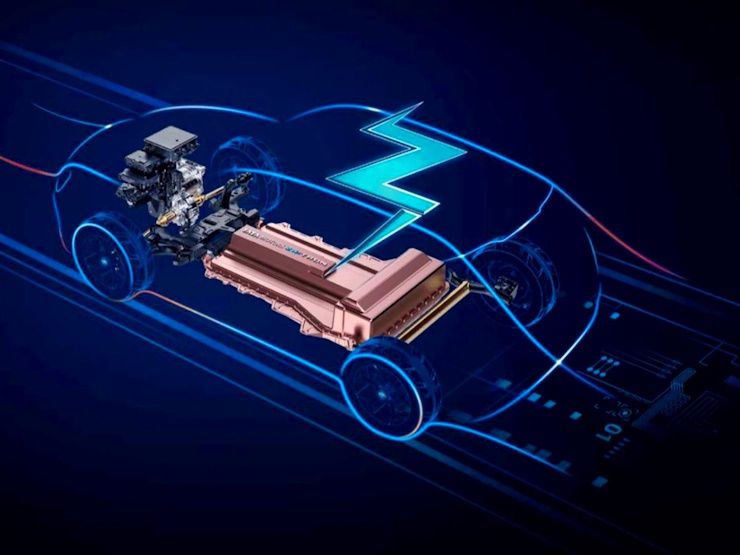Lightning Strikes BYD Electric SUV 3 Times: Driver Walks Away Unharmed, Car Driveable [Video]


What happened in Guangxi Province, China, sounds almost unbelievable. A BYD Song Plus electric SUV, driving through the Tieshan service area during a thunderstorm, was struck by lightning not once, but three times in quick succession. The dramatic moment, caught on the car’s dashcam, showed arcs of electricity visibly dancing across the roof of the vehicle.
Yet, when the storm passed, the driver stepped out unharmed. Even more surprising, the SUV showed no major damage. The battery, electric motor, and control systems remained intact. The incident has now become a striking case study in both automotive engineering and basic science, particularly the physics that protect passengers in these kinds of events.
The survival of the driver wasn't down to luck. It was science, specifically, the Faraday cage effect. First explained by Michael Faraday in the 19th century, this principle describes how an enclosed metal structure redirects electrical currents around its exterior. In this case, the BYD SUV’s metal body conducted the lightning’s energy across the surface and down to the ground, rather than allowing it to pass through the cabin.

As a result, the interior remained a safe space. Occupants inside a metal-bodied vehicle share the same electrical potential as the vehicle body, meaning there is no current flowing through them. The electricity travels around the person, not through them.
A post-incident inspection confirmed that the core electric systems, the power battery pack, the control unit, and the motor, were fully functional. Only two burn marks were visible on the roof, showing the points where lightning had struck. The rest of the car’s structure was untouched.
What makes this case unusual is not that the occupant survived. That’s expected in well-built metal vehicles struck by lightning. What’s surprising is that the electronic systems inside the electric SUV didn’t fail, despite three direct strikes.

Modern electric vehicles, including the BYD Song Plus, are packed with sensitive electronics. A lightning strike can produce electromagnetic pulses strong enough to interfere with or destroy such systems. Yet in this case, the vehicle’s protective features kicked in. BYD’s inbuilt power cutoff system activated immediately, shielding the electronics from surge damage. This kind of response is a result of deliberate engineering, aimed at preventing damage during unpredictable electrical events.
The incident shows that electric vehicles, when properly designed, can resist the destructive force of lightning just as effectively, and sometimes even more effectively, than traditional petrol cars.
Most lightning strikes to cars follow a predictable path. The bolt typically lands on the antenna or the roof, travels along the vehicle's body, and exits through the tyres, which serve as a path to the ground. Along the way, damage can occur, melted antennas, shattered glass, or burned tyres.

But the BYD SUV seems to have avoided these problems. The only visible evidence of the lightning was the burn marks where it struck. No broken windows. No damaged wiring. No system faults.
According to the technician who examined the SUV afterward, someone with over a decade of experience, this was the first time he had ever seen a vehicle survive such an event without major damage. That rarity only highlights how robust this particular car turned out to be.

This case also draws attention to the often-overlooked safety features in electric vehicles. The BYD Song Plus uses Blade Battery technology, based on lithium iron phosphate. It is widely regarded as a safer chemistry compared to other lithium-ion batteries, especially in terms of thermal stability.
Add to that the multiple layers of protection in the electrical system, including insulation, isolation, and surge protection, and it becomes clear why the vehicle handled the event as well as it did. Electric vehicles lack flammable fuel systems, which further reduces the risk of ignition or explosion during a lightning strike.
For comparison, traditional petrol vehicles have been known to suffer fuel line ruptures or tank explosions when hit by lightning. The absence of such systems in an EV removes that particular danger.
The driver of the BYD followed the correct safety steps after the strike. They stayed inside the vehicle, avoided touching metal surfaces, and waited for rescue services. That decision likely made all the difference.
Safety experts recommend exactly this: stay inside the vehicle during a storm, keep your hands in your lap, and avoid contact with metal parts. Wait at least 30 minutes after the last sound of thunder before exiting.
While it might be tempting to inspect for damage immediately, doing so can be risky if the storm is still active. Following these protocols increases the chances of walking away safely, as this driver did.
Car companies can test for crashes, fire, and water exposure, but they cannot easily simulate lightning strikes in real-world testing. This makes such incidents valuable, even though no manufacturer would want one of their cars to be the test subject.
While this case shows that EVs can survive lightning, it’s important to recognise that the underlying safety comes from the vehicle’s metal shell and design, not the electric powertrain. A petrol car with a properly grounded metal frame would likely protect occupants just as well.
The difference lies in post-strike functionality. As vehicles become more digital, how well their electronics recover from electrical shocks matters. The fact that the Song Plus EV continued to function after the strikes suggests its designers anticipated such scenarios and prepared for them.
Lightning strikes on cars are rare, but they do happen. When they do, they test a vehicle in ways no factory trial can replicate. In this case, the BYD Song Plus passed the test, shielding its occupant and preserving its own systems.
For electric vehicle skeptics who question how these machines would hold up in severe weather, this is a useful reminder. With the right engineering, EVs are not only roadworthy, they’re storm-ready too.